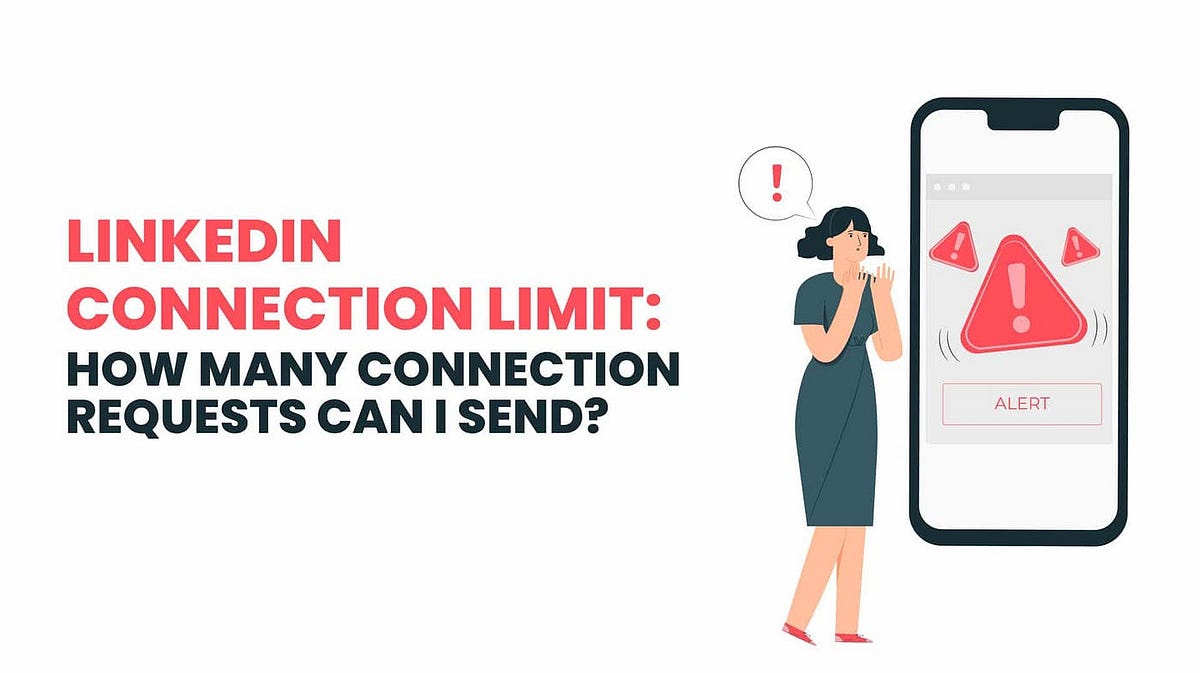In the vast professional landscape of LinkedIn, making connections is essential for networking and career growth. But have you ever wondered about the nuances of connection requests? Understanding how to effectively send and manage these requests can open doors to opportunities you didn't even know existed. With the right approach, you can maximize your connection potential and build a robust professional network that supports your career aspirations.
What Are Connection Request Limits on LinkedIn?

LinkedIn has established connection request limits to maintain a healthy user experience and prevent spam. So, what exactly are these limits?
As of now, LinkedIn allows you to send a maximum of 100 connection requests per week. This limit is designed to ensure that users engage meaningfully rather than sending mass requests indiscriminately. It encourages quality connections over quantity, which benefits everyone on the platform.
Here are some key points to consider regarding connection request limits:
- Weekly Cap: You can send up to 100 requests in a rolling seven-day period.
- Pending Requests: If you have too many pending requests, you may not be able to send new ones until some are accepted or withdrawn.
- Connection Limits: There is also a total cap of 30,000 connections on your profile, so it’s crucial to manage these effectively.
To stay within these limits, it’s important to be strategic. Focus on quality connections—people relevant to your industry or career goals. Personalize your connection requests with a brief note explaining why you want to connect. This can significantly increase your acceptance rates and make every request count.
Bear in mind that LinkedIn monitors user behavior. If you send too many requests that go unanswered, or if you receive a high number of "I don’t know this person" responses, it may affect your ability to send future requests. So, it's essential to build genuine relationships rather than simply expanding your network.
In summary, understanding and respecting LinkedIn's connection request limits is key to leveraging the platform effectively. By being intentional with your outreach and focusing on meaningful connections, you can maximize your networking potential without hitting a wall. Happy connecting!
Also Read This: How to Add Languages to LinkedIn? Updating Your LinkedIn Profile with Language Skills
3. Why Connection Request Limits Matter for Networking

When it comes to networking on LinkedIn, understanding connection request limits is crucial. You might wonder, "Why should I care about how many requests I can send?" Well, let’s break it down.
Connection request limits aren't just arbitrary numbers; they play a significant role in maintaining the integrity of the platform. Here’s why they matter:
- Quality over Quantity: LinkedIn encourages meaningful connections rather than random ones. By limiting the number of requests you can send, it pushes you to focus on building relationships with people who truly matter to your professional journey.
- Reputation Management: Excessive connection requests can harm your reputation. If you send too many requests without engagement, others may flag you as a spammer. This could lead to your account being restricted or, in the worst case, suspended!
- Strategic Networking: Knowing your limits helps you to be more strategic. Instead of mass-sending requests, you'll take time to personalize each one, making your approach more effective and increasing your chances of acceptance.
- Referral Growth: When you connect with the right people, you enhance your chances of receiving referrals. A well-curated connection list can open doors to opportunities. Think about it: a strong connection in your field can lead to job offers, collaborations, or mentorship.
In conclusion, while it might seem frustrating to have limits, they actually provide a framework to ensure that every connection you make has the potential to be meaningful. So, take this as an opportunity to refine your networking strategy and focus on quality connections that align with your goals.
Also Read This: Does LinkedIn Automatically Repost Jobs? What You Should Know
4. How to Check Your Current Connection Request Status

Now that you understand the importance of connection request limits, you might be wondering how to keep track of your current status. Luckily, checking your connection requests on LinkedIn is a straightforward process!
Here’s a simple step-by-step guide:
- Log into Your Account: Start by logging into your LinkedIn account. Make sure you're using the latest version of the app or the website for the best experience.
- Go to the My Network Section: Once you're logged in, navigate to the "My Network" section on the homepage. It's usually represented by a network icon at the top of the page.
- Check Connection Requests: In the "My Network" section, you’ll see a box on the left that shows your pending connection requests. Click on “Manage” to view all the details.
- Review Sent Requests: If you want to see the requests you've sent, look for an area that displays "Sent Requests." This will show you who you’ve reached out to and whether they’ve accepted your request.
- Keep an Eye on Your Limits: LinkedIn doesn’t display a specific number of requests you have left, but if you find yourself unable to send more requests, you’ll know you’ve hit the limit!
By regularly checking your connection request status, you can manage your networking efforts more effectively. Remember, being mindful of your current connections and requests can help you maximize your LinkedIn experience.
Also Read This: How to Merge Two LinkedIn Accounts
5. Strategies to Maximize Your Connection Requests
Maximizing your LinkedIn connection requests isn’t just about hitting that “connect” button; it’s about building meaningful relationships that can enhance your professional network. Here are some effective strategies to help you get the most out of your connection requests:
- Personalize Your Requests: Instead of the standard message, take a moment to customize your invitation. Mention a shared interest, comment on a recent post, or refer to a mutual connection. For example, “Hi [Name], I noticed we both attended the same conference last year. I’d love to connect and exchange insights!”
- Utilize LinkedIn Groups: Engage in groups relevant to your industry. Participating in discussions can help you identify potential connections. After contributing valuable insights, send requests to those who resonate with your thoughts.
- Follow Up: If someone accepts your connection request, send a thank-you message. This can lead to further dialogue and opens the door for deeper networking opportunities. Consider saying something like, “Thanks for connecting! I look forward to sharing ideas with you.”
- Leverage Alumni Networks: Use LinkedIn’s alumni tool to find former classmates or colleagues. Reaching out to alumni can foster a sense of camaraderie and trust, making them more likely to accept your request.
- Engage with Their Content: Before sending a request, engage with the person’s posts by liking or commenting. This can increase your visibility and make your request more recognizable when they see it pop up.
Implementing these strategies can help you stand out and enhance your chances of connecting with professionals who can influence your career positively.
Also Read This: Adding Freelance Work to LinkedIn: A Step-by-Step Guide
6. Best Practices for Sending Connection Requests
When it comes to sending connection requests on LinkedIn, following best practices can greatly enhance your success rate. Here’s how to do it right:
| Best Practice | Description |
|---|---|
| Keep it Professional | Remember that LinkedIn is a professional networking site. Maintain a professional tone in your requests. Avoid overly casual language or emojis. |
| Be Selective | Don’t just connect with anyone. Focus on individuals who align with your career goals or interests. Quality connections are more valuable than a large quantity. |
| Limit Your Daily Requests | LinkedIn has connection limits to prevent spam. Aim to send a reasonable number of requests each day (around 20-30) to avoid being flagged. |
| Follow Up with Non-Responders | If someone hasn’t responded to your request after a week, consider sending a polite follow-up message. It can be as simple as, “Just wanted to touch base on my connection request!” |
| Be Patient | Not everyone will accept your request immediately—or at all. Don’t take it personally. Focus on nurturing the connections that do accept you. |
By adopting these best practices, you can significantly improve your connection success on LinkedIn and cultivate a more robust professional network.
Also Read This: How to Save LinkedIn Learning Videos on Your PC for Offline Viewing
7. Common Mistakes to Avoid with Connection Requests
When it comes to sending connection requests on LinkedIn, there are several pitfalls that can hinder your networking efforts. Avoiding these common mistakes can significantly improve your chances of building meaningful connections. Let’s explore the key missteps:
- Skipping the Personal Note: One of the most significant errors is sending a generic connection request without a personal note. Always take a moment to craft a brief message explaining who you are and why you’d like to connect. This makes you stand out in a crowded inbox.
- Connecting Without Context: Connecting with someone without providing context can come off as impersonal. For instance, if you attended the same conference or share a mutual interest, mention that! It shows you’re genuinely interested in the individual, not just expanding your network.
- Overloading Your Requests: Avoid sending too many requests at once. LinkedIn has connection limits, and flooding the platform with requests can lead to your account being temporarily restricted. Pace yourself and focus on quality over quantity.
- Ignoring Profile Completeness: Before sending out connection requests, ensure that your profile is complete and professional. A half-finished profile can deter potential connections. Include a professional photo, a compelling headline, and relevant experience.
- Not Following Up: If someone accepts your request, don’t forget to follow up! Send a thank-you message or ask a question to kickstart the conversation. This helps turn a simple connection into a meaningful relationship.
- Targeting the Wrong Audience: Make sure you’re connecting with individuals who align with your professional goals. Casting a wide net can lead to connections that don’t add value to your network. Focus on quality connections that can support your career aspirations.
- Being Overly Promotional: Avoid using connection requests as a platform to pitch your services or products. Instead, focus on building relationships first. Once a rapport is established, then you can introduce your offerings organically.
By steering clear of these common mistakes, you can enhance the effectiveness of your connection requests and foster a network that supports your professional growth.
8. Conclusion: Making the Most of Your LinkedIn Connections
Maximizing your LinkedIn connections is all about strategy, authenticity, and engagement. Once you’ve successfully sent out connection requests and built a robust network, it’s important to nurture those relationships. Here are some ways to make the most of your connections:
- Engage Regularly: Don’t let your connections gather virtual dust! Interact with their posts by liking, commenting, or sharing. This keeps you on their radar and shows that you value their insights.
- Share Valuable Content: Position yourself as a thought leader by sharing articles, insights, or your own experiences related to your industry. This not only adds value to your connections but also enhances your visibility.
- Ask for Introductions: If you come across someone in your network who can help you with your goals, don’t hesitate to ask for an introduction. Most people are happy to help if you approach them politely.
- Join Groups: Participate in LinkedIn groups related to your industry or interests. This expands your network further and allows you to connect with like-minded professionals.
- Stay Updated: Regularly review your connections’ profiles for updates. Congratulating them on new positions or projects can lead to deeper conversations and a strengthened relationship.
In conclusion, LinkedIn is a powerful tool for professional networking, but it’s only as effective as the effort you put into it. By avoiding common mistakes and actively engaging with your connections, you can cultivate a thriving network that supports your career journey. Remember, the key to successful networking lies in building genuine relationships over time!
 admin
admin








